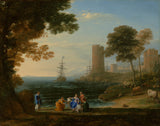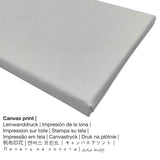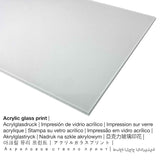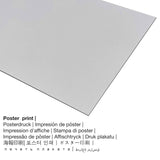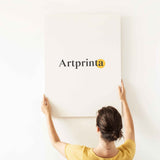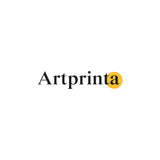Claude Lorrain, 1645 - Nleba anya n'ụsọ oké osimiri na mpụ nke Europa - mbipụta nka mara mma
Ụtụ gụnyere. Mbupu gbakọrọ na ndenye ọpụpụ.
Ọkachamara nke narị afọ nke 17 nwere aha Coast View with the Abduction of Europa kere site na Baroque onye na-ese ihe Claude Lorrain in 1645. It is part of the collection of Ụlọ ihe ngosi nka nke J. Paul Getty, nke bụ akụkụ nke ntụkwasị obi J. Paul Getty na bụ otu n'ime ụlọ ọrụ nka kacha ukwuu n'ụwa niile. Ọ na-achọ ịkpali ọchịchọ ịmata ihe gbasara, na ịnụ ụtọ na nghọta nke nka a na-ahụ anya site n'ịchịkọta, ichekwa, igosipụta na ịkọwa ọrụ nka nke àgwà pụtara ìhè na mkpa akụkọ ihe mere eme.. Site n'ikike nke Ụlọ ihe ngosi nka nke J. Paul Getty (license - public domain).The creditline of the artwork is the following: . Furthermore, alignment of the digital reproduction is landscape and has a side ratio of 4: 3, which implies that the length is 33% longer than the width. Claude Lorrain was a male painter, whose artistic style can primarily be classified as Baroque. The painter lived for a total of 82 years, born in the year 1600 in Champagne, Auvergne-Rhone-Alpes, France and deceased in the year 1682 in Rome, Roma province, Lazio, Italy.
Original information about the work of art from the museum's website (© Copyright - by The J. Paul Getty Museum - Ụlọ ihe ngosi nka nke J. Paul Getty)
The maiden Europa rests atop a white bull, unaware it is the god Jupiter in disguise. According to the tale in Ovid's Metamorphoses, soon the animal will abduct her across the waves. Until then, she and her attendants festoon the seemingly innocent beast with flowers, while her blue drapery flutters in the breeze. In the upper right corner, a hazy poetic light illuminates her home city of Tyre, further evoking an idyllic antique world.
Claude Lorrain is known for painting complicated images that achieve a tranquil balance. This scene appears bucolic, but his composition and details also hint of impending danger. Beyond the field of delicate flowers, for example, a craggy tower looms. The women fail to notice that the bull is poised in anticipation, already straightening one of his legs for flight. Whitecaps gather behind them on the darkening sea, the backdrop to Europa's fate.
Even in his day, Claude was known for developing a style called the Ideal Landscape, in which nature on the canvas surpasses the real thing in its beauty, harmony, and refinement. Here he balances formal elements, like the upright trees, ship, and towers, against the open expanse of sea and sky. Offshore, he juxtaposes the huge galleon and all its impeccable detail in the rigging and carved decoration, with Europa still on land. The maritime theme also had a deeper resonance for Claude's contemporaries, as in art criticism, the abduction of Europa was compared to a ship leaving shore.
French by birth, and working in Rome, Claude often went into the countryside to do studies of nature. One of his hallmarks is the use of a unifying light, which gives this work a kind of gentle glow. The romance is punctuated by long shadows coming in from the left, distinctive of his favorite afternoon light, which help frame the drama at center stage.
Tebụl a haziri ahazi nke ọrụ nka
| Aha eserese ahụ: | "Coast View with the Abduction of Europa" |
| Nhazi nke ọrụ nka: | sere |
| Otu izugbe: | nka ochie |
| oge: | 17th narị afọ |
| Emepụtara n'afọ: | 1645 |
| Ogologo afọ nka nka: | 370 afọ |
| Ụlọ ihe ngosi nka / ebe: | Ụlọ ihe ngosi nka nke J. Paul Getty |
| Ebe ngosi nka: | Los Angeles, California, Njikota Obodo Amerika |
| E Nwere na: | Ụlọ ihe ngosi nka nke J. Paul Getty |
| License: | ngalaba ọha |
| Site n'aka: | Ụlọ ihe ngosi nka nke J. Paul Getty |
Tebụl onye na-ese ihe
| Aha onye nka: | Claude Lorrain |
| Aha ndị ọzọ: | Cluade, Lorenis, Loren Claudio, Claude of Lorraine, C. Loranese, Claude la Lorain, C. Laurain, Gillee Le Lorrain Claude, Glaude Sorrin, Gio: Carlo Loréno, Claudius Gelle, Claudio Gele, C. de Lorraine, claude gelee gen. lorrain, Claude Gelé dit le Lorrain, Cl. Lorrain, Gloude Loronois, Clode Loraine, Claude Lorrain, Claude Loirainois, C. Le Lorrain, Claudio Lorenese, Claude (Claude Lorrain) Gellée, le Lorain Claude, Glaude Laurainois, Lorena Claudio di, Claude Gelée genannt Lorrain, Claude Lauren, Claude dit le Lorrain, Claude Gellée gen. Claude Lorrain, Glaude Lorenois, Msù Claudio Lorenese, [Claude Lorrain], Lorense Claudio, Lorrain Claude Gelee gen. Le Lorrain, Claude Gellée dit Le Lorrain, Loranese, Monsu` Claudio, Lorineses Glaudo, C. Loraneze, Claudio Rorenese, Lorraine, Lorrain Claude Gelee gen., Glot la Raing oder Claudius Gelee, C. Laurin, Glaude d'Loraine, Gloude Loranois, Le Lorrain, Gellée Claude (Claude Lorrain), Claude Gelée dit le Lorrain, Claude Gelez dit le Lorrain, Gellée le Lorrain Claude, Gelleè Lorenese Claudio, C. de Lorrain, Claude Gellé gen. Le Lorrain, Gelee Claudius, Msù Claudio, Claudio Gelée, Claude le Lorrain or Claudius Gelée, Claude le Lorrain, Claudius Gelee, Claud de Loraine, Claude Gelée gen. le Lorrain, Claude Gille, Cl. le Lorrain, Claude Gelée dit le Lorrin, Lorrain Claude, C. Gelée dit le Lorrain, Claude, claude gellee gen. lorrain, Glaude de Lorainois, Claude Gellee Le Lorrain, Claude Lorraine, Claud Lorraine, Claude Gelée genannt Le Lorrain, Claude Lourin, Cl. Gelée dit Le Lorrain, C. Loraine, Lorenese Claudio Gelée, Glaude Lornois, Claude de Lorin, Glaude Lauranois, Claud. Loraine, C. Lorrain, Gelee Claude, Gellée Claude, Claude Le Lorin, Claude Lorraine, Claude Lorrain, Claude Gelée dit Lelorrain, Claudio di Lorena, Glaude Loronois, ז'לה קלוד (המכונה קלוד לורין), Glaudo Lorinees, Claudio Loren, Claude de Lorrain or Claudius Gelée, Claude Lorrain (Claude Gellée), Monsu Claudio, Clot la Raing oder Claudius Gelee, Claude Loreen, Claude Loranese, Cl. Lorraine, Claude L'oronois, Claud. Lorrain, Cladio Gelleè Lorenese, Claude-loraine, Lorrain, Glaude de Loronoy, Claud de Lorain, Claude Gélé dit Le Lorrain, Glaude Lorraine, Lorraine Claude, Monsù Lorense, Claud Loraine, Claude Gellee gen. Le Lorrain, Claude Lorain, Gloude Lorenois, Claude Lorenois, Clodio, Lorenese, Lorain Claude la, Claudio Gilet Lorraine, Le Lorrain Claude, Claudius Gelée genannt Claude Lorrain, Claude Gellé dit le Lorrain, Claude Gelée, Claude le Lorain, Lorenese Claudio, Claudio Lurinese, Cl. Gelée dit Le Lorrain, Glaude Lorenne, Clauade, Claude Gelleé Le Lorraine, Gellée Claude Lorrain, Claude Gele dit Lorraine, Claude Le Laurain, Claude Laurrin, claude gelee gen. lorrain, Claude Lorin, Claude Loraine, Claude Lorraine French, Glaude Loranois, Claude Lorainois, Lorrain Claude de, Claude le Lorraine, Claude Gelee Called Claude Lorrain, Gelée Claude gen. Lorrain, Gelée dit Claude le Lorrain, Cloth. de Loraine, Lorrain Claude Gellée, Claude Lorrraine, Gelè Claudio, C. Lorraine, Claudio da Lorena, Claude Gelé dit Lorraine, Lorin, Claude Gele'e dit le Lorrain, Cla. Lorraine, Claude Gelee genannt le Lorrain, Claude Gelee called Le Lorraine, Claud, Claudio Gelleè Lorenese, Claude Gielis de Larins, Glaude Loranoijs, Glaude, Glaude Lorainois, Claude Gelée dit le Lorrain, Claude Gellée Le Lorrain, Claudele Lorrain, Cl. Lorain, Lorena Claudio, Gelleé Le Lorraine Claude, Claude Lorrains, Claude Gelée dit Claude le Lorrain, Claude le Loraine, Loraine Claude, Carlo Loranze, Claudio Loroinese, Clode Lorraine, G. De Lorain, Monsu Claudio Lorenese, Claudio Lorense, Claudio Loranese, Claude Lorrain Eigentlich Claude Gelee, Lorain Claude, Claud Lorain, Claud. Larenese, Lorain, Monsu Clodio, Lorena Claudio de, Carlo Loraneze, Claudie, Claude de Lorraine, Gloude Lornois, lorrain claude, Claude Gellée, Lorrain Claude le, Charles de Lorrain, Claude Laurain, Claudio, Claud Lorrain, Claude De Laureins, Lorrain Claud., Gelè Claude, C. Gelée dit le Lorrain, Ch. |
| okike nke onye nka: | nwoke |
| Obodo onye nka: | French |
| Ọrụ: | onye na-ese ihe |
| Obodo onye nka: | France |
| Nhazi nke onye nka: | nna ukwu ochie |
| Ụdị nka: | Baroque |
| Oge ndu: | 82 afọ |
| Amụrụ n'afọ: | 1600 |
| Ebe amụrụ onye: | Champagne, Auvergne-Rhone-Alpes, France |
| Afọ nwụrụ: | 1682 |
| Nwụrụ na (ebe): | Rome, Rome Province, Lazio, Italy |
Akụrụngwa ị nwere ike isi na ya nweta
Na nhọrọ mwepu ngwaahịa ị nwere ike họrọ nha na ihe onwunwe dịka mmasị onwe gị si dị. Ị nwere ike ịhọrọ n'ime nhọrọ nhazi ngwaahịa ndị a:
- Mbipụta akwụkwọ mmado (akwa akwa akwa): Our poster print is a UV printed canvas paper with a nice surface texture. Please note, that depending on the absolute size of the poster we add a white margin of approximately 2-6cm round about the painting in order to facilitate the framing with your custom frame.
- Bipụta na iko acrylic (nke nwere ezigbo mkpuchi iko): An print on acrylic glass, often named a plexiglass print, will convert the original into great home decoration. Your favorite work of art is being made with the help of modern UV direct printing technology. The image effect of this are deep and vivid colors. Our real glass coating protects your selected fine art print against light and heat for between 40-60 years.
- Metal (aluminium debond mbipụta): An Aluminium Dibond print is a print material with an impressive depth. The non-reflective surface make a contemporary look. The Direct Print on Aluminum Dibond is your ideal start to fine art replicas on aluminum. For our Direct Print On Aluminum Dibond, we print your chosen artwork onto the surface of the white-primed aluminum composite. The bright components of the original artpiece shimmer with a silky gloss, however without any glare.
- Mbipụta kwaaji: The printed canvas, which should not be confused with a painting on a canvas, is a digital copy printed on a cotton canvas material. Hanging a canvas print: A canvas print has the advantage of being relatively low in weight, meaning that it is easy and straightforward to hang your Canvas print without the help of any wall-mounts. A canvas print is suited for any type of wall.
Nkọwapụta edemede
| Nkewa edemede: | mmepụta nka |
| Mmeputakwa: | dijitalụ mmeputakwa |
| Usoro mmepụta: | Mbipụta UV ozugbo |
| Nlụpụta: | arụpụtara na Germany |
| Ụdị ngwaahịa: | a na-achọ |
| Ojiji ngwaahịa: | art ebipụta gallery, mgbidi ịchọ mma |
| Nhazi nka nka: | usoro odida obodo |
| Ụdị anya: | ogologo ruo obosara 4: 3 |
| Oke onyonyo pụtara: | ogologo bụ 33% ogologo karịa obosara |
| Akwa mmeputakwa dị: | ígwè obibi akwụkwọ (aluminium dibond), ebipụta canvas, mbipụta enyo acrylic (nwere ezigbo mkpuchi iko), mbipụta akwụkwọ mmado (akwụkwọ kwaaji) |
| Nhọrọ nha nke akwa akwa n'elu etiti ihe na-agbatị (mbipụta kwaaji): | 40x30cm - 16x12", 80x60cm - 31x24", 120x90cm - 47x35", 160x120cm - 63x47" |
| Mbipụta iko acrylic (nke nwere ezigbo mkpuchi iko): | 40x30cm - 16x12", 80x60cm - 31x24", 120x90cm - 47x35", 160x120cm - 63x47" |
| Mpempe akwụkwọ mmado (akwụkwọ kwaaji) nha dị iche iche: | 40x30cm - 16x12", 80x60cm - 31x24", 120x90cm - 47x35" |
| Nhọrọ nha mbipụta aluminium dibond: | 40x30cm - 16x12", 80x60cm - 31x24", 120x90cm - 47x35" |
| Nhazi mmeputa nka nka: | biko mara na ebipụta nka enweghị okpokolo agba |
Nkwupụta iwu: We try our best in order to depict our art products with as many details as possible and to demonstrate them visually on the respective product detail pages. Nevertheless, the colors of the print materials, as well as the printing can differ to a certain extent from the presentation on your device's screen. Depending on your screen settings and the nature of the surface, color pigments might not be printed as exactly as the digital version. Because all our art prints are processed and printed manually, there may as well be minor variations in the size and exact position of the motif.
© Nwebiisinka nke - Artprinta.com (Artprinta)

